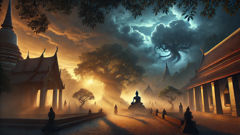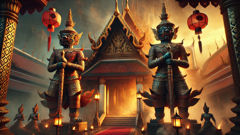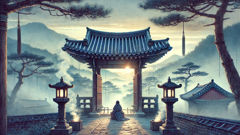Introduction
Long before the city of Auckland stood at the edge of a glimmering gulf, when the land of Aotearoa was young and its forests whispered secrets only the wind could carry, the Maori of Tamaki Makaurau looked to the swelling tides of the west for their stories. The Manukau Harbour sprawled across the coast, its arms reaching deep into the heart of the land, its waters shimmering beneath an endless sky. To the tangata whenua, the original people of this place, every inlet, headland, and sandbar was more than a mark on the map; it was a living memory, shaped by the hands of gods, heroes, and creatures whose size and strength could humble the mountains. Among these ancient stories, few were as revered as the legend of Te Pehi o Aotea—the giant stingray, whose struggle against fate and mankind carved the very bones of the harbour itself. In those days, the people of the iwi, the tribes, gathered by smoky fires, their eyes reflecting the gold of the setting sun, their voices rising in song and story. Elders spoke of a time when creatures of immense mana, spiritual power, roamed the land and sea. It was said that Te Pehi o Aotea was no ordinary fish, but a taonga, a treasure of the deep, born in the heart of Tangaroa, god of the oceans. Its wings spread wider than a canoe, its tail flicked with the force of a storm. The stingray was a guardian and a challenge—a test for the bravest fishers and a warning for those who took more than they needed. The legend begins with the people, their canoes hugging the shoreline as they set out in search of sustenance, and with the stingray, gliding through the kelp forests and shifting sands, watching, listening, and—when threatened—unleashing its full, unearthly strength. From the depths of Te Moana-nui-a-Kiwa, the great Pacific, to the swirling tidal mouths of the Manukau, the battle that followed would change the land forever, leaving scars and sanctuaries that endure to this day. This is the story of how the will of one mighty creature shaped the world, and how the people who witnessed its struggle found new respect for the forces that bind earth, sea, and sky.
The Whispering Tides and the Arrival of Te Pehi o Aotea
In the earliest days, when the land was still soft from the shaping hands of the atua, the gods, the harbours of Aotearoa stretched like the open mouths of whales, breathing the salty air. The Manukau Harbour, vast and mysterious, was home to spirits, taniwha, and creatures that glided beneath its surface unseen by mortal eyes. The people who settled on its shores—Ngaiwi, Ngati Whatua, and Te Kawerau a Maki—built their pa on the hills and lived in harmony with the tides, taking only what they needed from the sea. The ocean was both provider and judge, generous in bounty yet swift in punishment for greed or disrespect.
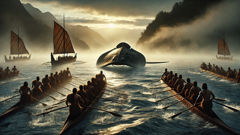
On a morning when the fog clung low over the waters, a child named Maire stood on the shell-strewn shore, watching ripples that spread like silver threads across the bay. The elders spoke of omens—rays that soared in the shallows meant a time of plenty, but when the water stilled and turned glassy, it foretold a visitor of great power. Maire’s eyes, sharp as a harrier hawk’s, caught a flicker beneath the surface. There, gliding with impossible grace, was Te Pehi o Aotea. Its body was vast as a woven mat for the whole iwi, its eyes black and deep as night. The creature’s wingtips stirred clouds of silt, sending tiny fish scattering. Its tail lashed with a force that made Maire’s heart leap in awe and terror.
Word spread quickly. The tohunga, wise ones, gathered by the water’s edge, their chants carried by the breeze. They offered karakia, prayers, to Tangaroa, seeking protection and guidance. The presence of such a being was both a blessing and a challenge. Some among the warriors, hungry for renown, whispered of hunting this giant. Others urged restraint, speaking of tapu, the sacredness that shielded certain creatures and places from harm. Yet hunger gnawed at the village. The seasons had been hard—fish scarce, gardens battered by storms. The people gazed at the stingray and saw hope and danger entwined.
Te Pehi o Aotea moved through the harbour as if it owned every current. Some said it was searching for something lost in the silt; others believed it was sent as a test by Tangaroa himself. At night, its shadow glided past canoes, silent as drifting clouds. Children dreamed of its tail thrashing against the moonlit waves. For days, it lingered in the bay, feeding on mollusks and stirring up the seabed until the shellfish returned in abundance. But as the hunger grew, so too did the temptation to capture this taonga. The elders warned, but whispers spread like fire on the wind.
In the darkness before dawn, a group of young warriors made ready. They carved barbed spears from manuka wood and lashed their canoes together for stability. Maire, drawn by curiosity and dread, hid among the flax baskets in one waka. As the canoes glided out onto the glassy water, the air trembled with anticipation. When the first spear was thrown, it barely grazed the stingray’s wing. Te Pehi o Aotea shuddered and surged, its tail slicing through the water like a blade. Waves crashed against the canoes, tossing men into the froth. The warriors shouted, thrusting their spears in desperation. The stingray’s power was immense—each beat of its wings churned up sand and stone from the depths, turning the water cloudy and wild.
The struggle grew fierce. The tide itself seemed to rise in anger, swirling around the canoes. Maire clung to the side, heart pounding as the stingray turned beneath them, its eyes locking with hers for a brief, unforgettable moment. She saw no malice—only pain and confusion. With one final, titanic surge, Te Pehi o Aotea broke free from the spears and fled toward the western reaches of the harbour. The warriors, exhausted and battered, limped home in shame. The tohunga spoke of the cost: when tapu is broken, the land remembers. And so began the changes that would shape the Manukau Harbour for generations.
The Wrath of Tangaroa and the Birth of the Harbour’s Shape
In the aftermath of the battle, the harbour was forever changed. The elders watched as waves lashed the shore harder than ever before. Storms arrived out of season, and strange currents pulled driftwood and debris into swirling eddies that had never existed. Some said it was Tangaroa’s anger, a response to the wounds inflicted upon his treasured guardian. Others believed it was Te Pehi o Aotea itself, reshaping the land in its pain and desperation to escape.
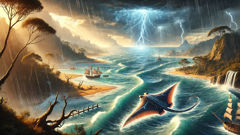
The night after the battle, Maire lay awake in her wharenui, the communal house. Rain drummed on the roof, and thunder growled over the hills. The dreams that came were vivid—she floated above the harbour, watching as the giant stingray thrashed its wings, carving deep channels through mud and sand. Each sweep of its body gouged trenches that filled with seawater, forming new inlets and tidal flats. The land groaned under the force, trees toppling where water tore at their roots. Maire awoke with a sense of awe and fear, certain that what she had seen was more than a dream.
At dawn, the people found parts of their shoreline washed away, new sandbars jutting into the bay, and ancient boulders exposed where water had never reached before. In the west, near the wild heads where the harbour met the Tasman Sea, the tides ran stronger than anyone could remember. The tohunga gathered at the water’s edge to offer new karakia, seeking to appease Tangaroa and ask forgiveness for their transgression. They placed greenstone and shell on woven mats as gifts, and sang songs that rose above the sound of waves breaking.
Te Pehi o Aotea was seen only in glimpses after that—its shadow moving along new channels, its wingtips stirring up plumes of mud. Maire followed it along the shifting shoreline, witnessing how its passage deepened the water and created new sandbanks where birds flocked and shellfish returned. Over time, channels grew broader, arms of land separated by swirling tides. The stingray’s struggle left a scar across the face of Manukau Harbour—a network of waterways that would one day guide canoes and feed generations.
Yet, the changes brought hardship too. Some gardens were lost to saltwater, and fishing became unpredictable. The people learned to adapt, moving their homes higher on the hills and finding new ways to harvest the sea’s gifts. They watched as flocks of kuaka—godwits—landed on fresh mudflats each spring, and mullet schooled in the deeper pools carved by Te Pehi o Aotea’s flight. The elders began to tell a new story: that the harbour itself was the mark of a guardian’s pain and power, a reminder that land and sea are forever bound by what we do and what we take.
The New Covenant: Guardianship and Renewal
In the years that followed, life along the Manukau Harbour was marked by caution and respect. The wounds left by Te Pehi o Aotea’s struggle had become part of the landscape: deep tidal estuaries cradled by gentle hills, sandbars where herons stalked for fish, and sheltered coves that offered refuge from the wild Tasman winds. The people rebuilt their pa further inland and taught their children that every eel, shellfish, and bird was touched by the story of the giant stingray.

Maire grew into a young woman known for her wisdom and compassion. She became a kaitiaki, a guardian of her people’s relationship with the sea. With each season’s change, she led groups to gather kai moana—seafood—teaching them to take only what was needed and to leave offerings for Tangaroa. On moonlit nights, she would sit by the new channels, telling children how the harbour was shaped by both courage and consequence. Her voice echoed across the water: "Remember Te Pehi o Aotea. When we act without care, we change not only ourselves but the world around us."
One spring morning, as mist lifted from the flats, Maire saw a smaller stingray gliding along the shallows. It bore the same markings as the legendary guardian but was gentle, almost shy. She knew then that Te Pehi o Aotea had not disappeared entirely—its descendants would continue to watch over the harbour. She wove new patterns into her kete, baskets, depicting the swirling shapes of stingrays and channels. The tohunga praised her for reminding the people that every living thing had its own tapu, its own sacred place in the order of the world.
As generations passed, the people of Manukau learned to read the tides as a language. They marked seasons by the return of birds and fish, and celebrated the bounty that came when respect was shown to all living things. The story of Te Pehi o Aotea became more than a warning; it was a guide for how to live well within the embrace of land and sea. The harbour remained a place of abundance and beauty—a living testament to the power of legends and the wisdom of those who listen.
In time, other tribes heard the tale and carried it to distant shores. They spoke of a place where a giant stingray’s pain carved waterways through rock and sand, creating a home for countless creatures and people. Visitors who came to fish or trade were told: "Tread lightly. This harbour is alive with memory. Its guardian may sleep beneath the mud, but its story moves in every ripple and every breeze." And so the legend endured—woven into the very shape of Aotearoa’s west coast, a reminder that nature’s gifts are both fragile and fierce, shaped by the choices of those who call this land home.
Conclusion
Today, if you stand on the wind-swept headlands above Manukau Harbour and listen to the sighing tides, you may still sense the presence of Te Pehi o Aotea. The channels and sandbars remain—a living map drawn by the struggles of a legendary guardian. Every ripple and eddy carries echoes of ancient stories, reminding us that creation is born from both conflict and care. The harbour’s abundant life is a gift that endures only as long as it’s respected. The people of Tamaki Makaurau still honour these lessons: to walk gently on the land, to gather with gratitude, and to remember that all things are connected—creatures, people, sea, and sky. In the enduring legend of Te Pehi o Aotea, the spirit of kaitiakitanga—guardianship—flows on, shaping each new generation as surely as tides shape the shore.










